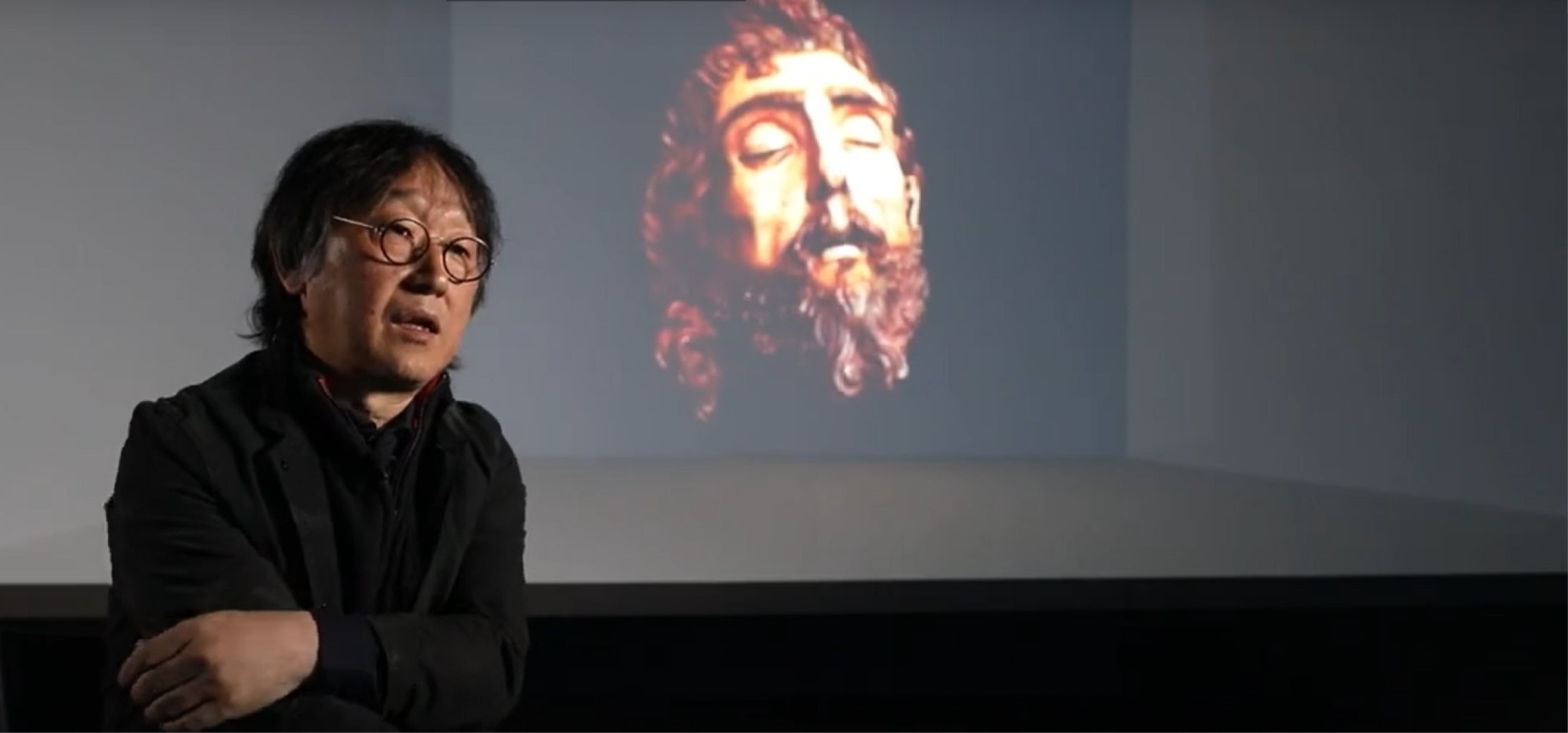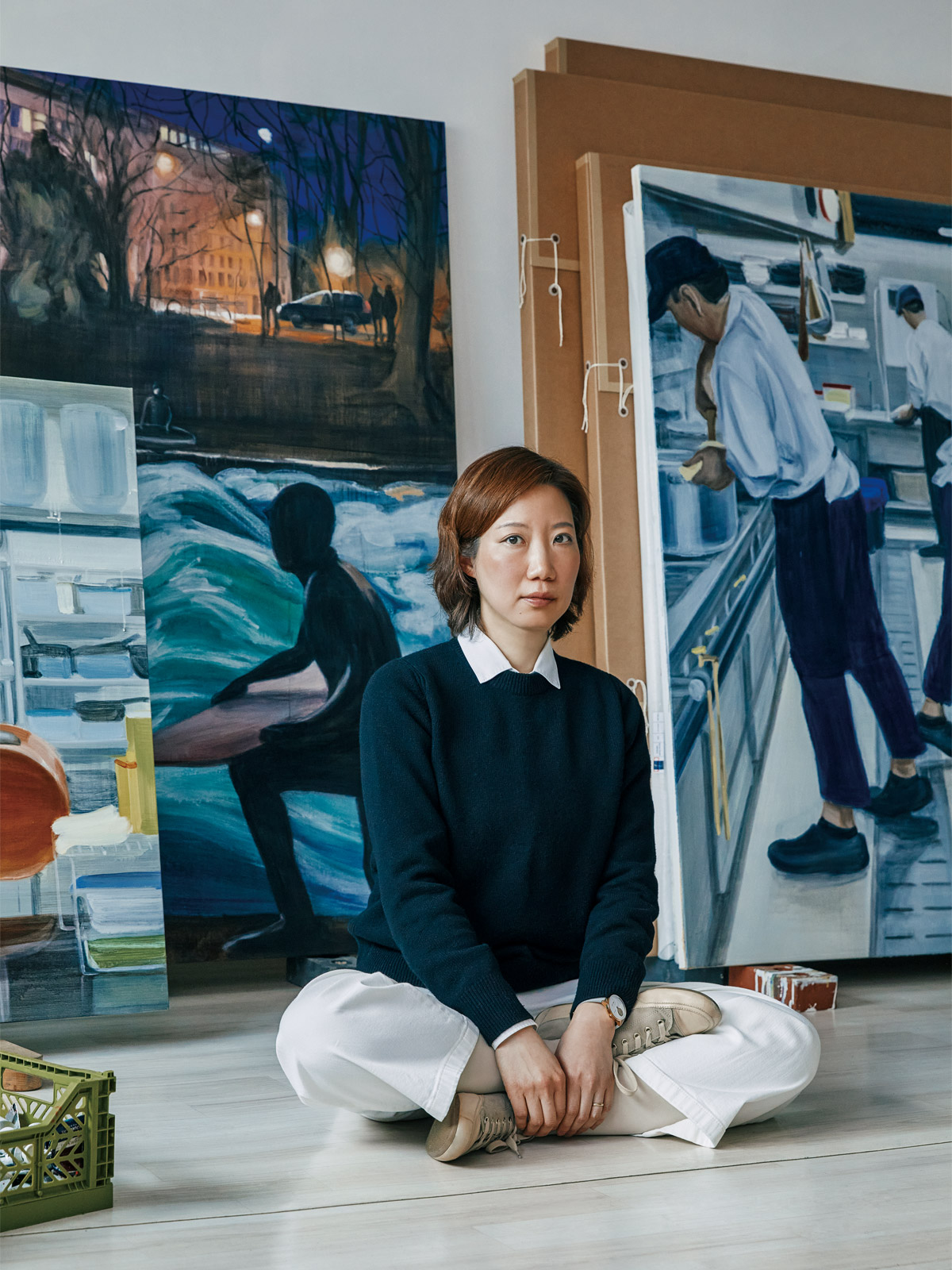Kyungah
Ham (b. 1966) is an artist who persistently delves into the gaps of
contradictions and absurdities, challenging the rules and taboos of hidden
systems behind reality. She has addressed these invisible social structures and
phenomena through various mediums, including painting, installation, video,
performance, and embroidery.
Ham's
work traverses both within and beyond the realm of art, actively communicating
with others across unreachable borders or by traveling around the world. Her
work manifests as a condensed form of such labor-intensive expressions and the
uncontrollable variables of the process.
 Kyungah Ham, Chasing
Yellow, 2000-2001 ©MMCA
Kyungah Ham, Chasing
Yellow, 2000-2001 ©MMCAFrom 2000 to 2001, the artist traveled
to Asian countries including South Korea, Japan, China, and Vietnam, creating a
documentary-style video work titled Chasing Yellow,
in which she followed people wearing yellow clothing and interviewed them. The
work consists of eight channels, each featuring interviews that capture the
lives of eight different individuals.
According to the artist, yellow in
this work represents 'a promise to start a relationship.' By connecting the
diverse personal lives of the individuals through the common element of the
color yellow, the artist reveals the cultural, institutional, and religious
implications embedded within.
 Kyungah Ham, Odessa
Stairs, 2007 ©Gyeonggi Museum of Modern Art
Kyungah Ham, Odessa
Stairs, 2007 ©Gyeonggi Museum of Modern ArtOn the other hand, Odessa Stairs (2007) is a work composed of discarded furniture and materials from the renovation of the house of a former president, who was the last leader of the military dictatorship. This massive staircase, which resembles an altar, is strewn with miscellaneous items from the dictator's home, including a bidet, chairs, golf shoes, carpets, loudspeakers, tiles, and a shopping cart.
 Battleship Potemkin Poster
©Battleship Potemkin
Battleship Potemkin Poster
©Battleship PotemkinThe title ‘Odessa Stairs’ refers to the location of the massacre scene during the Russian Revolution in Sergei M. Eisenstein's film Battleship Potemkin (1925). Through this work, the historical fact of the suppression of the democratization movement in Korea is compared to the political repression depicted in the film. Just as Battleship Potemkin used montage techniques to address political narratives, Kyungah Ham's Odessa Stairs combines various items to edit and present the private domain of the former president alongside the tragic history of Korean politics.
 Kyungah Ham, Museum
Display, 2000-2010 ©Art Sonje Center
Kyungah Ham, Museum
Display, 2000-2010 ©Art Sonje CenterFrom 2000 to 2010, Kyungah Ham worked on Museum Display, a project that addresses the plunder and violence perpetrated by past powerful entities, which have been tacitly accepted and ignored, hidden under the guise of 'art' through museums. Museum Display adopts the exhibition format of a museum, treating the display cases themselves as both a museum and a representation of it.
 Kyungah Ham, Museum
Display, 2000-2010 ©Art Sonje Center
Kyungah Ham, Museum
Display, 2000-2010 ©Art Sonje CenterKyungah Ham stole items such as
teacups, plates, and spoons from museum cafes and shops, and over ten years,
she amassed a large collection of stolen goods, which she displayed in a manner
resembling a museum exhibit. Through this, she critiques the inherent power and
human desire for materialism present in traditional museums.
Each item is labeled with the date and
place of the theft, openly confessing her actions in contrast to the usual
practices of museums. Museum Display thus reenacts
the looting of the imperialist era as a contemporary crime, bringing it into
the present and strategically revealing the realities and hidden aspects of
cultural imperialism.
 Installation
view of “Kyungah Ham: Phantom Footsteps” ©Kukje Gallery
Installation
view of “Kyungah Ham: Phantom Footsteps” ©Kukje GalleryKyungah Ham's representative work, the ‘Embroidery Project,’ began in 2008 when she found North Korean propaganda leaflets in front of her house. Inspired by this, the artist created her own leaflets to communicate with North Korean residents, despite the ban on civilian exchanges. She designed embroidery patterns using texts and images related to war and terrorism found online, along with excerpts of pop song lyrics and short greetings, and sent them to embroidery craftsman from North Korean through a broker in China.
 Needling
Whisper, Needle Country / SMS Series in Camouflage / At First, it is the dark
01-001, 2013-2015,
Needling
Whisper, Needle Country / SMS Series in Camouflage / At First, it is the dark
01-001, 2013-2015, North Korean hand embroidery, silk threads on cotton, middle man, anxiety, censorship, bribe, wooden frame, approx.,
1200hrs/ 2persons, 198 x 138 cm
Despite numerous unpredictable
challenges and risks, the patterns were delivered to the North Korean embroidery
craftsman, who then crafted large-scale embroideries, and were transformed into
artworks by the artist. Behind the artistic aura of the vibrant colors and
aesthetic completion of these large-scale embroideries lies the condensation of
valuable materials, labor, time, and a tumultuous process.
In her 2015 solo exhibition “Phantom
Footsteps” at Kukje Gallery, Ham presented the ‘Chandelier’ series,
where she displayed the reverse side of the embroideries, revealing the hidden
presence of North Korean workers, the collaboration process with them, and the
reality of the division. As suggested by the subtitle, ‘What You See Is the
Unseen,' these highly intricate and meticulous embroideries confront us with
the traces of unseen beings and realities disconnected from our own.
 Kyungah Ham, Soccer
Painting by the Soccer Ball Bouncing Over Crocodile River, 2016 ©MMCA
Kyungah Ham, Soccer
Painting by the Soccer Ball Bouncing Over Crocodile River, 2016 ©MMCA Kyungah Ham, Soccer
Painting by the Soccer Ball Bouncing Over Crocodile River, 2016 ©MMCA
Kyungah Ham, Soccer
Painting by the Soccer Ball Bouncing Over Crocodile River, 2016 ©MMCAAt the
“Korea Artist Prize 2016” exhibition at the National Museum of Modern and
Contemporary Art Korea, Kyungah Ham showcased works centered on the theme of
'defecting and settling' in collaboration with North Korean defectors. For
instance, the artist supported the costs of defection and documented the
arduous journeys of North Korean defectors. She also engaged a young defector
who dreams of becoming a national soccer player as a performer.
Among
these works, Soccer Painting
by the Soccer Ball Bouncing Over Crocodile River
captures the traces of a performance where the boy, who crossed the Crocodile
River on the Vietnam-Cambodia border during his defection, dribbled a
paint-drenched soccer ball freely in a mini soccer field set up in the
exhibition space.
 Kyungah Ham, Soccer
Painting by the Soccer Ball Bouncing Over Crocodile River, 2016 ©MMCA
Kyungah Ham, Soccer
Painting by the Soccer Ball Bouncing Over Crocodile River, 2016 ©MMCANext to
this, soccer shoes engraved with quotes from the boy's words and an interview
video detailing his defection journey are displayed. The boy's dreams, pursued
despite the risk of death, along with the artist's artistic commitment, are
woven into vibrant colors and abstract forms on the floor and walls of the
exhibition space.
Kyungah
Ham stated, ”Art and the artist's role are to reveal what exists but do not
exist.” According to the artist, this act is a journey of chasing 'phantom
footsteps.' Under the shadow of immense power, all beings, such as North Korean
laborers and defectors, exist like invisible ghosts, and the artist's work
involves following their footsteps, finding them, and communicating with them.
“I
often refer to the terms "library and laboratory" as the practical
approach to my work. Literally, the library is a place where
everything—history, culture, humanity, and systems—are compiled, and in a
broader and fundamental sense, the library is the world we live in. Events
observed here are thrown back by the artist, the alchemist, into the field of
experimentation.
My
interest lies in questioning and doubting the relationship between personal
experiences in this expansive sense of the library and how those experiences
might not be just personal incidents.'” (Jongho
Kim, Ryu Han Seung, ‘Kyungah Ham,’ Young Korean Artists 45: Interviews,
Da Vinci Gift, 2006, p. 245)
 Artist Kyungah Ham
©Kukje Gallery
Artist Kyungah Ham
©Kukje GalleryBorn in 1966, Kyungah Ham received a
bachelor's degree at the Seoul National University with a major in painting,
later also earning a Master's at the The School of Visual Arts New York City
(SVA NYC). Of her major solo exhibitions early in her career are “Desire &
Anesthesia” (Art Sonje Center, Seoul, 2009), “Such Game” (Ssamzie Space, Seoul,
2008), and “Room with a View” (Alternative Space LOOP, Seoul, 1999).
Recently, Ham participated in
exhibitions such as “The Shape of Time: Korean Art after 1989” (Philadelphia
Museum of Art, 2023, Minneapolis Institute of Art, 2024); “Hallyu! The Korean
Wave” (Victoria and Albert Museum, London, 2023, The Museum of Fine Art,
Boston, 2024, The San Francisco Asian Art Museum, 2025); and “Active Threads”
(KAI10/ Arthena Foundation, Düsseldorf, 2021).
She has also participated in many
projects, including “Korea Artist Prize 2016” (National Museum of Modern and
Contemporary Art Korea, Seoul, 2016), the 1st Asia Society Triennial (Asia
Society Museum of Modern and Contemporary Art, New York, 2020); the 10th Taipei
Biennale (Taipei National Museum of Art, 2016); and the 5th Guangzhou Triennial
(Guangdong Museum of Art, Guangzhou, 2015).
References
- 올해의 작가상, 함경아 (Korea Artist Prize, Kyungah Ham)
- 국립현대미술관, 함경아 | 체이싱 옐로우 | 2000 – 2001 (National Museum of Modern and Contemporary Art Korea (MMCA), Kyungah Ham | Chasing Yellow | 2000-2001)
- 경기도미술관, 함경아 – 오데사의 계단 (Gyeonggi Museum of Modern Art, Kyungah Ham - Odessa Stairs)
- 아트선재센터, 함경아: 욕망과 마취 (Art Sonje Center, Kyungah Ham: Desire & Anesthesia)
- 국제갤러리, 유령 발자국 (Kukje Gallery, Phantom Footsteps)




















